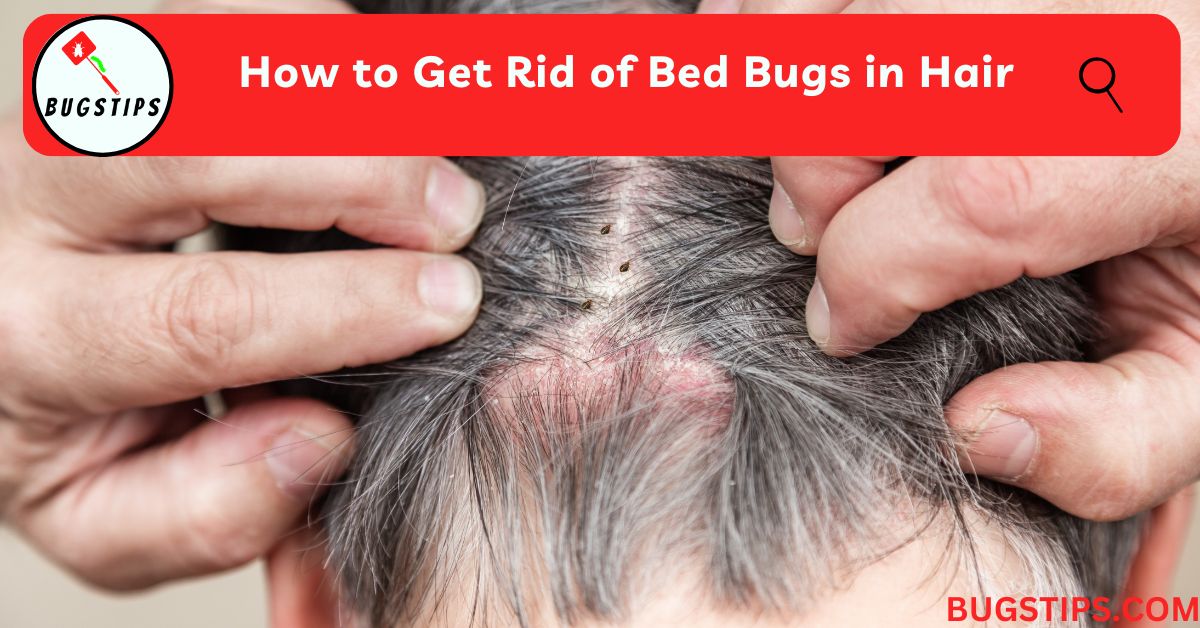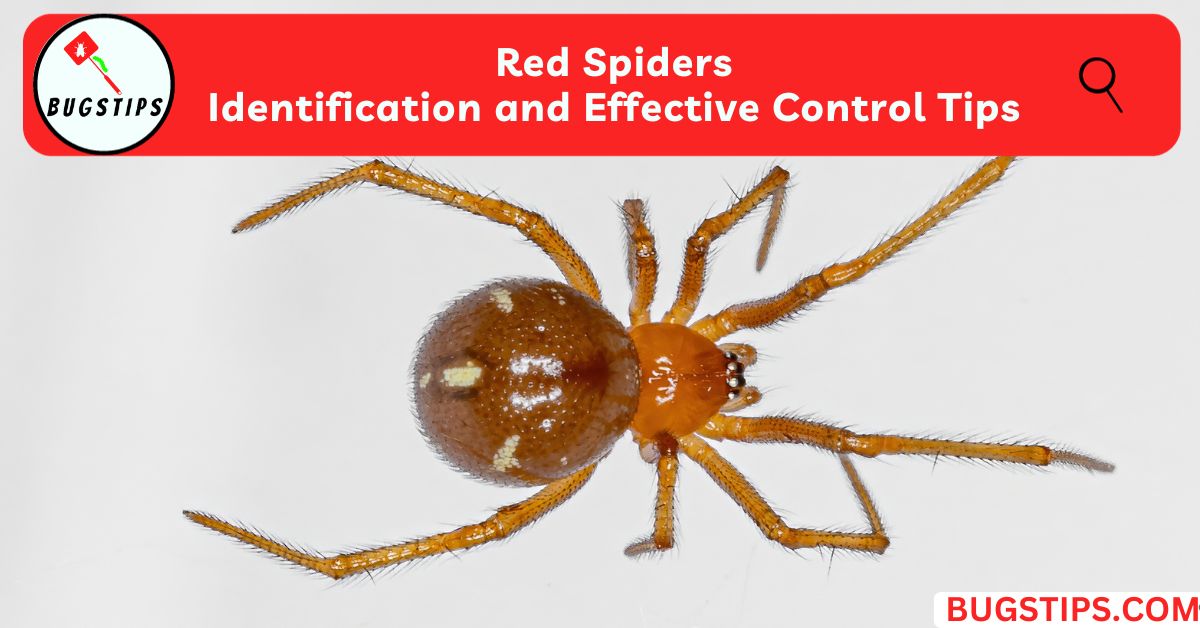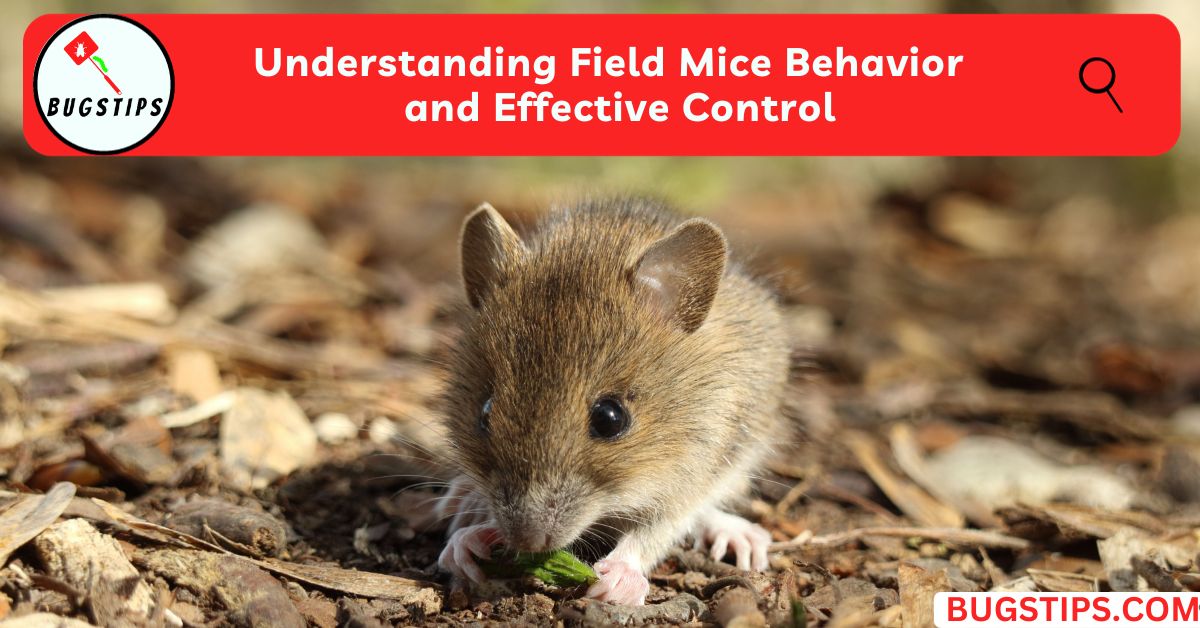This post may contain affiliate links which means as an Amazon Associate, this site may earn a small commission on qualified purchases made through links at no extra cost to you. Learn more on Affiliate Disclosure
Small, tiny brown bugs in house are a common problem that can be difficult to deal with.
These pests come in various shapes and sizes, including skinny brown bugs, tiny round brown bugs with hard shells, and even some that can fly. They can be found in different areas of the house, such as basements, crawl spaces, and storage areas.
In this article, we’ll explore the common types of small tiny brown bugs in house and discuss why they might be in your house. We’ll also provide tips on how to prevent these pests from making a home in your house, and if you’ve already noticed them, we’ll discuss ways to get rid of them.
So, if you’re dealing with small, tiny brown bugs in your house and want to learn more about them, keep reading!
Related Article – 10 Long Skinny Black Bugs in House
What Are These Small, Tiny Brown Bugs in House?
If you’ve noticed small, tiny brown bugs in your house, it’s important to identify the specific type in order to understand their behavior and potential impact on your home.
There are several types of small brown bugs that can infest homes. Here are some common small, tiny brown bugs found in houses.
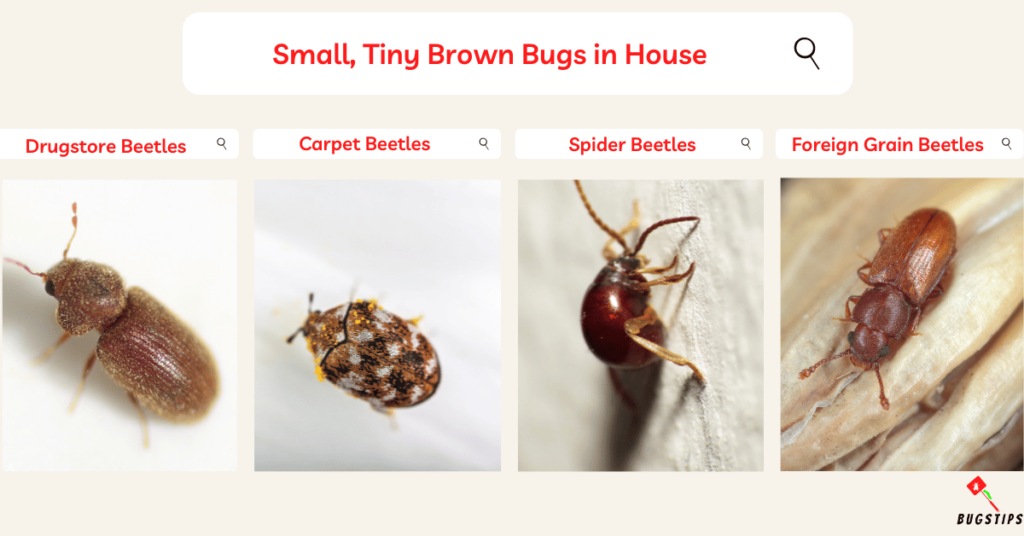
Drugstore Beetles
- Drugstore beetles are small, tiny brown bugs that are attracted to stored products such as grains, seeds, and packaged food products.
- These beetles, also known as bread beetles or biscuit beetles, measure about 2 to 4 mm in length and have a reddish-brown coloring with fine grooves along their wing covers.
- They typically enter homes attracted by light at night and seek out stored food inside.
- However, most often, they are brought into homes through infested grocery products and dry animal food.
- While drugstore beetles may not be a welcome sight in your house, they are not harmful to humans, animals, or structures.
- it’s important to note that the larval stage of drugstore beetles causes the most damage.
Related Article – 8 Bugs That Look Like Lint and Bite
Carpet Beetles
- Carpet beetles are small, tiny brown bugs that are oval-shaped and come in a range of colors from black to various mottled patterns of white, brown, yellow, and orange.
- They belong to the family Dermestidae, which includes species that feed on several dry animal and plant products.
- These pests can damage fabrics, furnishings, and clothing that contain natural animal fibers like wool, silk, hair, bristles, fur, or feathers.
- Synthetic items are generally resistant to their attacks, but mixtures of synthetic and natural fibers can still be damaged.
- Carpet beetles can also live on lint, hair, and debris accumulating under baseboards, inside floor vents, and ducts.
Spider Beetles
- Spider beetles are small, tiny brown bugs that get their name from their appearance, somewhat resembling small spiders or large mites due to their long legs and relatively large, rounded abdomens
- They prefer damp locations and readily feed on foodstuffs spoiled by moisture.
- Spider beetles can be found within walls, attics, cracks in wooden floors, and even in the nests of birds and rodents.
- These pests can remain active at temperatures below freezing and typically have one to two generations per year, depending on ambient temperature and relative humidity.
Related Article – 13 Bugs That Look Like Black Sesame Seeds
Foreign Grain Beetles (Plaster House Bugs)
- Foreign grain beetles, also known as plaster house bugs, are small, measuring about 1/12 inch in length.
- They have a reddish-brown color, flattened bodies, clubbed antennae, and small round bumps or peg-like projections behind their heads.
- These beetles primarily feed on mildews and fungal spores, and they can become abundant indoors, especially in new homes that sustain mildew on newly installed lumber or sheetrock.
- They can also be pests in bathrooms or other areas where high humidity permits the growth and development of both the insects and their food.

Khapra Beetles (Cabinet Beetles)
- Khapra beetles also referred to as cabinet beetles, are small brown bugs that measure about 1/12 inch in length.
- They have flattened bodies, clubbed antennae, and small round bumps or peg-like projections behind their heads.
- Khapra beetles are one of the world’s most destructive pests of grain products and seeds, and they are considered one of the 100 worst invasive species globally.
- Infestations can be challenging to control due to the beetles’ ability to survive without food for long periods, their preference for dry conditions and low-moisture food, and their resistance to many insecticides.
- They can be found in areas where grain and other potential food are stored, such as pantries, malt houses, grain and fodder processing plants, and stores of used grain sacks or crates.
Related Article – 12 Tiny Black Bugs on Window Sill
Saw-Toothed Grain Beetle
- Saw-toothed grain beetles are small, measuring about 1/4 to 3/8 inches when fully grown.
- They are among the most common pantry and cabinet-infesting beetles and readily enter homes from outside areas where they commonly feed on birdseed, flower pollen, and more.
- Saw-toothed grain beetles can attack almost any dry food, but they are most likely to be found in cereal products such as flour, cake mix, cornmeal, and macaroni, as well as other items like bread, dried fruits, nuts, chocolate, and dry pet food.
- Both adult and small, off-white (and light brown) larvae can be found in an infested food item, and the adult beetles often wander away from the infested material, potentially found inside cupboards or anywhere in the house.
Related Article – 15 Tiny Yellow Bugs | A Comprehensive Guide
Weevils
- Weevils are tiny small brown bugs commonly found in houses.
- They are a type of beetle, and there are many species of weevils, some of which have a brown coloration.
- They are often found in stored food products such as grains, cereals, and flour, and can also infest pet food.
- Weevils have a distinctive snout and are usually less than 6 mm in length.
- Infestations can be challenging to control due to the weevils’ ability to feed on various items.
Silverfish
- Silverfish are small bugs that have a silver-gray or brown coloration.
- They have a unique, carrot-like form, with a long and slender body that is broader at the front end and gradually tapers to the rear.
- Silverfish feed on organic substances such as book bindings, paper, fabrics, and cereals.
Related Article – Do Silverfish Bite?
- They can damage paper products like books, magazines, and etchings by removing the sizing and nibbling on the bindings.
- Silverfish prefer cool, damp environments, with their ideal temperature range being between 72 and 80 degrees Fahrenheit.
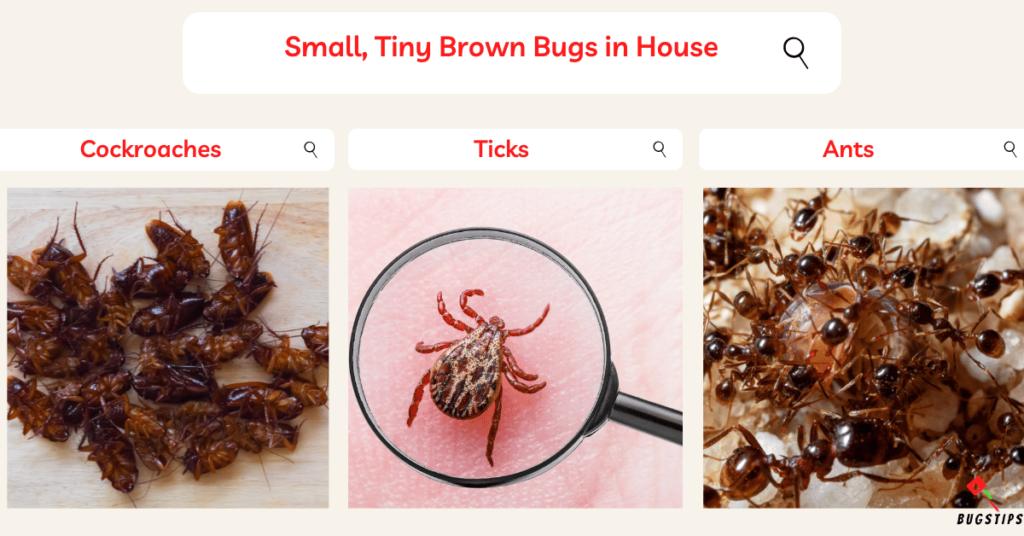
Cockroaches
- Cockroaches are pests that can be found in houses, and they come in various colors and sizes.
- Although not exclusively brown, they can appear in small, tiny brown forms.
- Cockroaches are among the most common pests infesting homes and apartments, particularly in areas where food preparation and sanitation practices are lacking.
Related Article – Do Cockroaches Play Dead? 10 Shocking Facts
- Brown-banded cockroaches, for example, can be found anywhere in the home, often in rooms other than kitchens and bathrooms.
- They prefer upper areas of ceilings, walls, cabinets, and closets, and can hide behind picture frames, wall decorations, and beneath or inside furniture.
- They are repulsive and can contaminate food, leave an unpleasant odor, and be an overall nuisance.
Ticks
- Ticks are eight-legged, blood-sucking insects that feed on the blood of various animals, including humans.
- Ticks typically have a dark brown body, but some species may also appear in lighter shades of brown.
- Ticks are known to carry diseases, making their presence in the house a cause for concern.
- They are usually brought into the home by pets or people who have been in tick-infested areas.
Related Article – 7 Little Black Bugs on Dogs Not Fleas!
Ants
- Ants are insects that come in various colors and sizes, including small, tiny brown ants.
- These brown ants may invade homes in search of food and shelter.
- They can be commonly found in kitchens, bathrooms, or anywhere there is a potential food source.
- While ants serve important ecological roles in the environment, their presence in the house can be a nuisance.
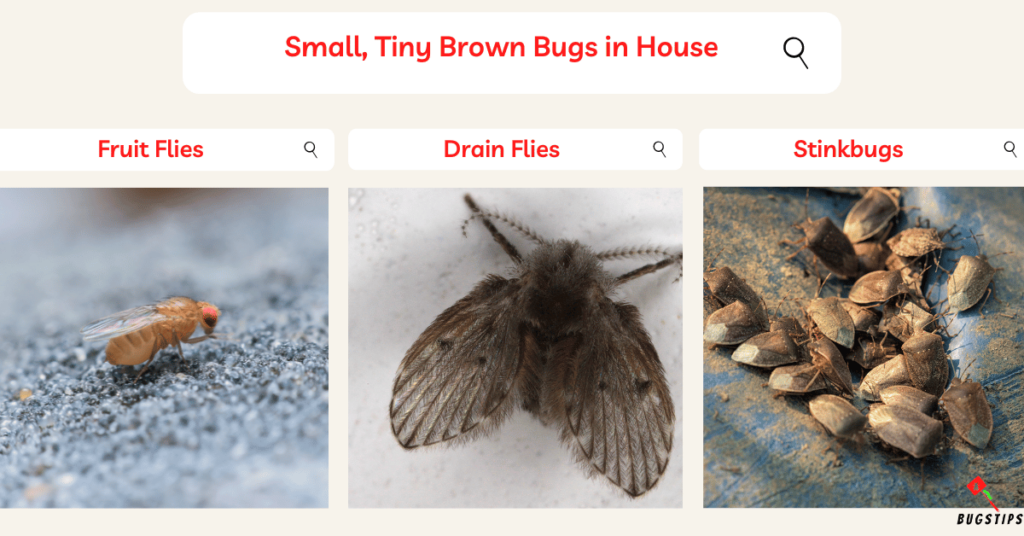
Fruit Flies
- Fruit flies are small, tiny brown bugs commonly found around ripe or decaying fruits and vegetables.
- These pests are attracted to the sweet, fermenting odors emitted by these food items, making the kitchen or other areas where food is present their preferred spaces.
- Fruit flies can quickly multiply in numbers, becoming a frustrating pest in the house.
Related Article – How to Get Rid of Fruit Flies in Fridge
Drain Flies
- Drain flies, also known as sewer flies or moth flies.
- They are typically brown, grey, or black in color and have a fuzzy appearance due to the fine hairs that cover their bodies.
- Drain flies are often found near drains, sewage systems, and other damp areas, as they require moisture to breed and develop.
- While drain flies are not harmful to humans, they can be a nuisance and can indicate a larger moisture problem in the home.
Related Article – 22 Bugs with Hard Shells | Top Tips to Eliminate
Stinkbugs
- Stink bugs are a type of small, brown bug that can infest homes.
- They are typically brown or dark brown in color and have a distinctive shield shape.
- While stink bugs do not pose a direct threat to humans, they can be a nuisance and emit a foul odor when disturbed or crushed.
- Stink bugs are attracted to light and warmth, and will often enter homes through cracks and gaps in windows, doors, and siding.
- They can be found in attics, basements, and other areas of the home where they can find shelter and warmth.
Why Are There Small, Tiny Brown Bugs in Your House?
The presence of small, tiny brown bugs in your house can be concerning and leave you wondering where they’re coming from. However, there are several reasons why these pests may be present in your home.
Here are some common reasons why those bugs are found in your house.
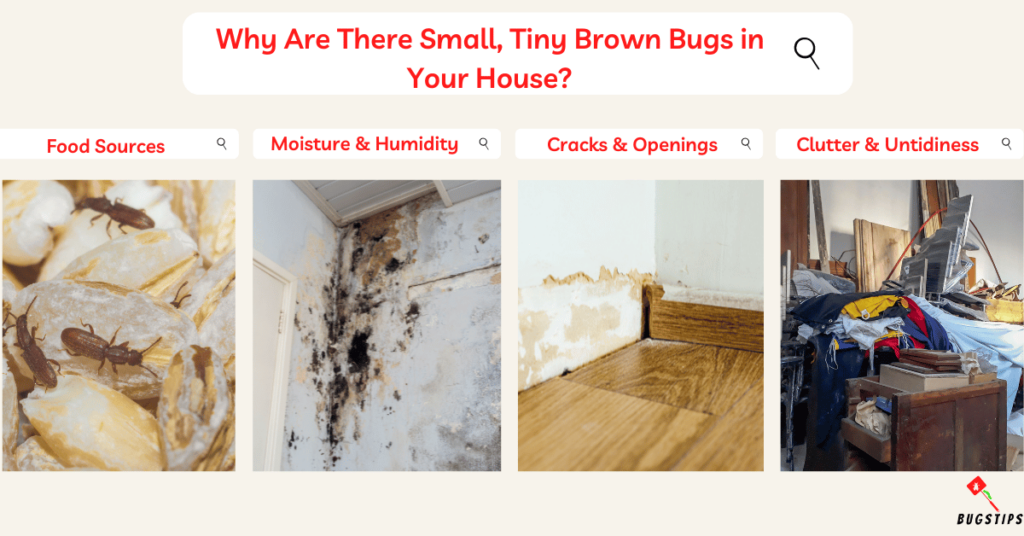
Food Sources
Small, tiny brown bugs are often drawn to sources of food. They can find their way into your house in search of crumbs, spills, or even stored food products.
These pests have a keen sense of smell and can detect even the tiniest food particles, making your kitchen and pantry particularly enticing.
Moisture and Humidity
Some bugs thrive in moist environments. Damp areas, such as bathrooms, basements, or areas with water leaks, can provide the ideal conditions for these pests to breed and multiply.
Excess moisture can attract them and create a suitable habitat within your house.
Cracks and Openings
Gaps, cracks, and openings in your home’s exterior can serve as entry points for small, tiny brown bugs.
They can easily squeeze through small crevices in doors, windows, or damaged walls.
Once inside, they may find shelter, food, and conducive conditions to establish themselves.
Clutter and Untidiness
Cluttered spaces and untidy areas can provide hiding places and favorable conditions for small, tiny brown bugs.
Piles of papers, stacks of clothes, or neglected storage areas can become breeding grounds or harborage sites for these pests.
Environmental Factors
Some small, tiny brown bugs are more prevalent during certain seasons or weather conditions.
For example, you may notice an increase in these pests during warmer months or when there are fluctuations in humidity levels.
Changes in environmental factors can influence their behavior and migration patterns.
You May Also Like – 5 Bugs with Lots of Legs | Ultimate Info Guide
Understanding these reasons can help you take natural steps to prevent infestations in the future.
How to Get Rid of Small, Tiny Brown Bugs in House?
If you have small, tiny brown bugs in your house, you need to get rid of them immediately.
Here we will explore some popular solutions that can help control these pests here.
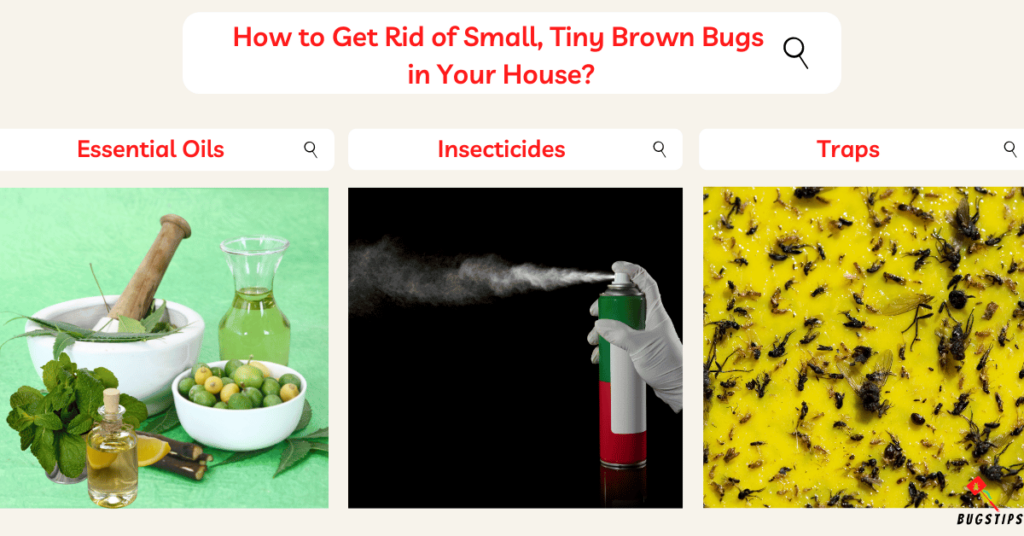
Essential Oils
- Two commonly used essential oils for bug control are neem oil and peppermint oil.
- Neem oil has insecticidal properties and can disrupt the life cycle of pests, while peppermint oil acts as a strong repellent.
- Dilute a few drops of either oil in water and spray the solution in areas where the bugs are present, such as entry points, corners, or infested areas.
Insecticides
- In cases of severe infestations or when other methods have proven ineffective, insecticides can be used as a last resort.
- Choose an insecticide specifically formulated for the target pests and follow the instructions carefully.
- Apply the insecticide in areas of bug activity, focusing on hiding spots, cracks, and entry points.
Traps
- Traps can be useful in monitoring and capturing small bugs.
- Sticky traps or adhesive tapes can be placed in areas of bug activity, such as near windows, doorways, or infested areas.
- The bugs will get stuck to the traps, allowing you to identify the severity of the infestation and take appropriate action.
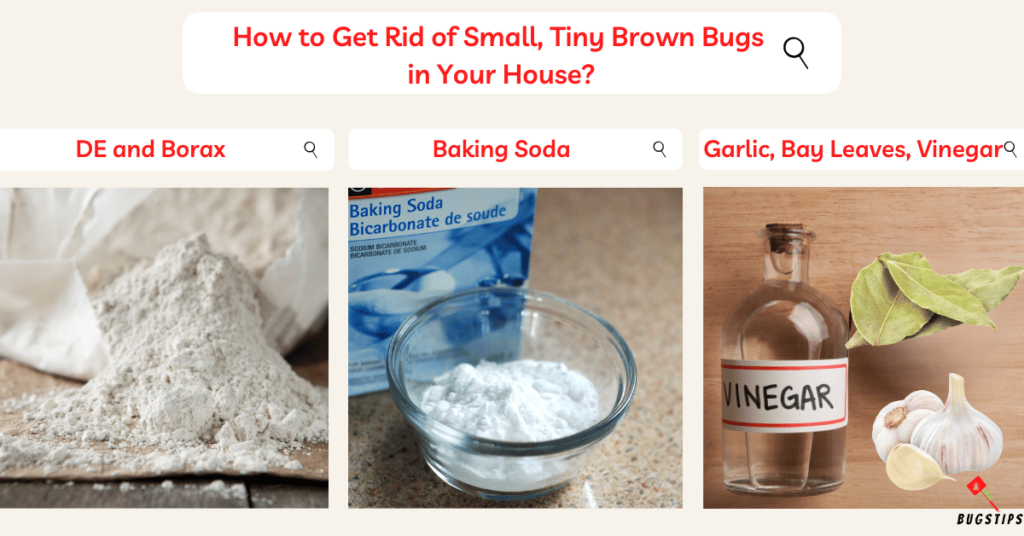
Diatomaceous Earth (DE) and Borax
- Diatomaceous earth is a natural powder made from fossilized diatoms.
- It is abrasive to the exoskeleton of small insects, causing them to dehydrate and die.
- Sprinkle a thin layer of diatomaceous earth in areas where the bugs frequent, such as cracks, crevices, or along baseboards.
- Borax, a mineral powder, can also be effective against small bugs.
- Apply borax in a similar manner, focusing on areas of activity.
You May Also Like – Little Black Bugs in My Car | Expert Removal Guide
Baking Soda
- Baking soda is another household ingredient that can help combat small, tiny brown bugs.
- Mix baking soda with water to create a paste and apply it in areas where the bugs are found or suspected, such as hidden corners, cracks, or infested surfaces.
- Leave the paste for a few hours, then wipe it away along with the dead bugs.
Garlic, Bay Leaves, and Vinegar
- These household ingredients can act as natural repellents against small bugs.
- Garlic has strong odor properties that deter pests, while bay leaves and vinegar also have repellent qualities.
- Place crushed garlic cloves, bay leaves, or vinegar-soaked cotton balls in areas where the bugs are present or in their suspected entry points.
- Replace them regularly to maintain their effectiveness.
Tips for Preventing Small, Brown Bugs in Your House
After successfully getting rid of small brown bugs in your house, it’s important to take preventive measures to avoid future infestations.
By implementing some effective tips and strategies, you can help prevent these pests from returning and also deter other bugs from entering your home.
Here are some simple methods that you can use.

Seal Entry Points
- Inspect your home for any cracks, gaps, or openings that could serve as entry points for bugs.
- Pay close attention to areas around doors, windows, utility pipes, and vents.
- Seal these openings using caulk, weatherstripping, or other appropriate sealants to create a barrier against bug intrusion.
You May Also Like – 9 Types of Swimming Pool Bugs
Maintain Cleanliness
- Keep your house clean and tidy, as clutter can provide hiding places for bugs.
- Regularly vacuum floors, carpets, and furniture to remove crumbs, debris, and any potential food sources.
- Wipe down countertops, tables, and other surfaces to eliminate spills and residues that can attract bugs.
- Regularly clean and sanitize drains using a mixture of baking soda and vinegar or a drain cleaner to remove organic matter and prevent the buildup of breeding sites.
- Trim shrubs and trees that come into contact with your house, as overhanging branches can serve as bridges for bugs to access your home.
- Keep your yard well-maintained, minimizing areas of excess moisture or debris that can attract bugs.
- Dispose of trash regularly in sealed bins and keep outdoor trash cans clean and tightly covered.
- Proper waste management helps reduce the attractiveness of your house to bugs looking for food sources.
Proper Food Storage
- Store food items, including grains, cereals, and dry goods, in tightly sealed containers.
- This helps prevent bugs from accessing and infesting your pantry or cabinets.
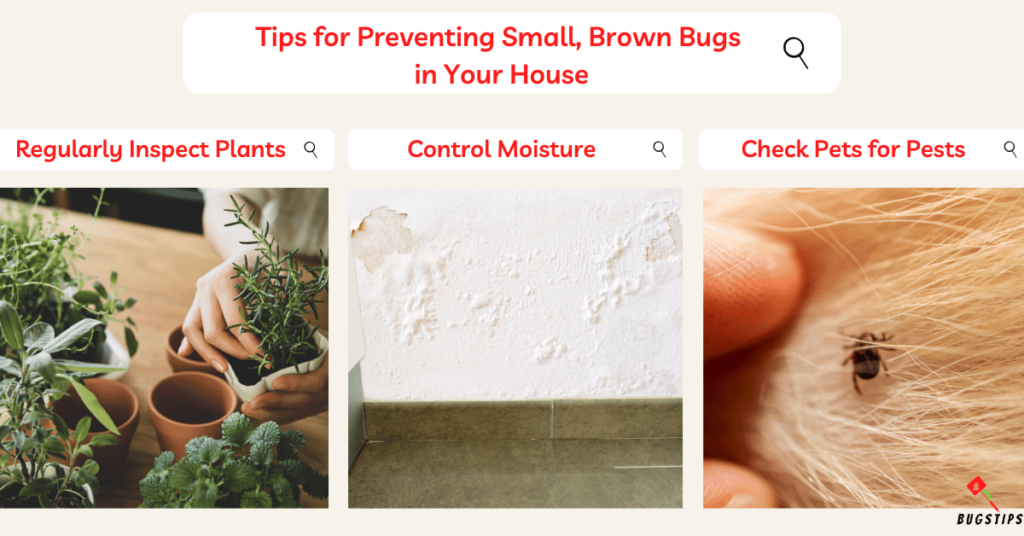
Regular Inspection of Plants
- If you have indoor plants, regularly inspect them for signs of infestation.
- Small bugs can hide in the soil, foliage, or crevices of potted plants.
- If you notice any signs of bug activity, isolate the affected plant and take appropriate measures to eliminate the pests.
Control Moisture
- Ensure proper ventilation in your house, especially in areas prone to moisture accumulation, such as bathrooms, basements, and crawl spaces.
- Good airflow helps reduce humidity levels, making your house less inviting to bugs that thrive in damp conditions.
Check Pets for Pests
- Small brown bugs can hitchhike on pets and be brought into the house.
- Regularly groom and clean your pets to minimize the risk of bugs hitching a ride into your home.
- Brush their fur, check for any signs of infestation, and promptly address any issues with appropriate treatments recommended by a veterinarian.
Final Thoughts
Identifying small brown bugs in your house is important in controlling and preventing infestations. Common types of small brown bugs include carpet beetles, silverfish, and bed bugs, which can cause damage and pose health hazards.
If you notice signs of an infestation or are unsure about identifying the pests, consult with a pest control professional for assistance.
By taking steps to prevent these pests from entering your home, such as regular cleaning and sealing entry points, you can keep your house free of small brown bugs without having to rely on harsh chemicals or expensive extermination services.
FAQs
Can small tiny brown bugs in the house cause harm to humans?
Small, tiny brown bugs in the house, such as drugstore beetles, carpet beetles, and weevils, are generally not harmful to humans. However, some bugs, like cockroaches, ticks, and stinkbugs, can carry diseases and pose health risks.
What are the tiny brown flying bugs in my house?
The tiny brown flying bugs in your house could be fruit flies or drain flies. Fruit flies are attracted to ripe or decaying fruits and vegetables, while drain flies thrive in moist environments like drains and bathrooms.
What are the tiny bugs that look like coffee grounds?
The tiny bugs that look like coffee grounds are often referred to as false chinch bugs. They are small, brown bugs that resemble small seeds or coffee grounds and are commonly found in dry, arid regions. False chinch bugs primarily feed on vegetation and are typically harmless to humans.
What are these small round brown bugs in my house?
The small round brown bugs in your house could be carpet beetles or spider beetles. Carpet beetles are oval-shaped and can vary in color from black to brown or mottled patterns. Spider beetles resemble small spiders with long legs and rounded abdomens.
What are small brown bugs with hard shells in the house?
These could be weevils or saw-toothed grain beetles. Weevils are a type of beetle with a distinctive snout and are commonly found in stored food products like grains and cereals. Saw-toothed grain beetles are pantry and cabinet infesting beetles that can attack various dry food items.
Resources – (for further reading)
Encyclopedia Britannica – List of beetles
The University of Minnesota – Home-invading weevils
The University of Maryland – Identifying Common Household Insect Pests


